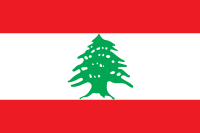Flag of lebanon
| Flag of lebanon | |
|---|---|
 |
|
| Vexillological symbol : |
|
| Aspect ratio: | 2: 3 |
| Officially accepted: | December 7, 1943 |
The flag of Lebanon was officially introduced on December 7, 1943.
meaning

The central symbol of the national flag goes back to the Maronite Christians , who wielded a white flag with a cedar tree in the 18th and 19th centuries . This tree, which symbolizes peace, brightness and eternity, is typical for this area and is therefore often mentioned in the Bible . So it is written in Ps 92:13 Lut that “the righteous [...] will grow like a cedar in Lebanon”.
Often the cedar is represented too small in the flag. The official rules governing the appearance of the flag state that the cedar must touch the red stripes.
The white color represents the purity and the snow that covers the peaks of Lebanon and red represents the blood of the martyrs of Lebanon's independence.
Sometimes the colors white and red are interpreted as the symbol for the two feuding tribes of the Yemenis and Kayssites , who split Lebanese society into two groups ( Christians and Muslims ) between 634 and 1711 .
However, this interpretation is seen as wrong by other quarters, since those who introduced the flag did not think of the split, but of the unification of the Lebanese against French rule.
There is speculation about connections between the designer of the flag Henri Pharaon and Austria, which could have influenced the coloring of the national flag with the red-white-red flag of Austria . The Austrian newspaper Der Standard reported in 2005 that the Christian parliamentarian and Lebanese foreign minister several times was an “enthusiastic friend of Austria”. According to the report, several generations of honorary consuls of the Austrian Empire and the Austro-Hungarian monarchy come from his family . Pharaon was also the founder of the Lebanese-Austrian Friendship Society. The other fathers of the national flag are Maroun Kanaan, Saêb Salam, Sabri Hamadé, Rachid Beydoun, Saadi al-Mounla and Mohamed al-Fadl, who chose Henry Pharaon as the new national flag.
The white, middle stripe is twice as wide as one of the red stripes.
Historical flags
There are claims that the Phoenicians had 1000 BC. A vertically divided blue-red flag was used, but these are not documented.
One of the oldest flags in what is now Lebanon is likely to have been the white flag of the Umayyads. It was followed by the black flag of the Abbasid Caliphate (750 to 1258). The Chehab emirate carried a blue flag with a white crescent moon (1697 to 1842).
In 1920 France received the League of Nations mandate over Lebanon, which it had occupied since 1919. Initially, a flag that corresponded to the Chehab emirate, with the French tricolor in the jack, may have been used for the entire mandate area (including Syria) . But already in August, the mandate area " Greater Lebanon " received its own flag. The Constitution of Lebanon, passed on May 23, 1926, confirmed it in Article 5: "The Lebanese flag is blue, white, red with a cedar in the white part". This cedar was defined as uniformly green, but flag manufacturers often also represented it in brown and green, which is also common with today's flag, which replaced the old flag in 1943.
 ? Umayyad Caliphate, 660 to 750
? Umayyad Caliphate, 660 to 750
2: 3 ? Lebanese flag after the collapse of the Ottoman Empire in 1918

 ? French mandate, July to August 1920
? French mandate, July to August 1920
2: 3 ? Greater Lebanon , 1920 to 1943

More flags in Lebanon
 ? Variant of the national flag with a brown trunk
? Variant of the national flag with a brown trunk
Web links
- Flags of the World - Lebanon (English)
Individual evidence
- ↑ The Lebanese national flag is based on the Austrian flag. Der Standard, March 6, 2005, accessed on July 17, 2009 : “The fact that Lebanon chose the red, white and red colors for its national flag - with a green cedar in the white middle field - was initiated by 1993 at the age of The Christian politician Henry Pharaon, who was an enthusiastic friend of Austria, was murdered 92 years ago. The Greek Orthodox banking family Pharaon, whose palace, which was partly destroyed in the civil war and later sold to the Saudi Arabian royal family, was one of the sights of Beirut, had provided honorary consuls of the Austrian Empire and the Austro-Hungarian Empire for several generations. Henry Pharaon was one of the founders of the Lebanese state that became sovereign in 1943 and was foreign minister several times and a member of parliament for four decades. He founded the Lebanese-Austrian Friendship Society. During the 15-year civil war (1975-1990), the billionaire took position for none of the conflicting parties. He spent the last years of his life at the Beirut luxury hotel Carlton, where he was murdered together with a bodyguard. "






